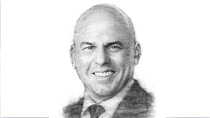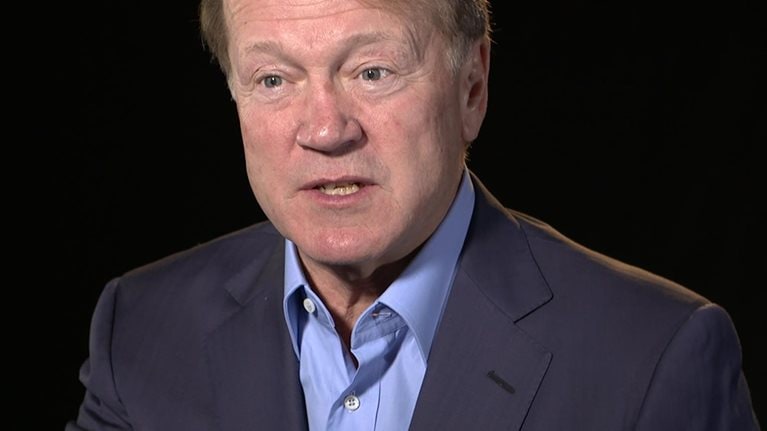Founded in China as Legend Holdings in 1984, the technology giant Lenovo has grown to become the world’s largest manufacturer of PCs: in mid-2016, industry analyst Gartner reported that the company’s global market share was more than 20 percent. Yet personal computers represent only part of the business. The data-center group is growing rapidly—sales are up 73 percent for the year ended March 31, 2016, reaching $4.6 billion.
And with Gartner reporting that total PC sales were almost 10 percent lower in the first quarter of 2016 than they had been a year earlier, Lenovo is making profound changes to take advantage of new opportunities. Gerry Smith, who recently became president of Lenovo’s data-center business after serving as chief operating officer of the PC and enterprise-business group, has been helping to oversee the company’s transformation. He spoke with McKinsey’s Karel Eloot, Christian Johnson, and Jean-Frederic Kuentz from his office in Silicon Valley.
McKinsey: In a rapidly changing technology environment, what are the most important strategic questions that Lenovo’s operations have had to address?
Gerry Smith: The main question is how to adapt to the major changes in customer requirements. Although the answers are similar across the organization, the reasons differ somewhat by sector. In the data-center business, for example, the challenge for the whole industry is to realign product portfolios more closely with what I would call the “new IT”—cloud-based, open-source, software-defined offerings that operate on a tightly integrated, hyperconverged1 architecture. That’s a huge transition requiring a stronger cost position, improved go-to-market capabilities, and deeper customer engagement.
For PCs and smart devices, the equivalent transition is from “speeds and feeds”—when customers compare products mainly on simple numbers, such as CPU2 speed—to a focus on ease of use, aesthetics, and industrial design. The standard laptop is evolving into a detachable, or hybrid, device that users can treat as a tablet, a laptop, a display—whatever best fits their needs at the moment. Again, the customer’s mind and requirements are completely different from what they were five years ago, so our primary task is to invest in understanding these needs and values. Yet we also have to keep tight control over costs.
McKinsey: The competitive landscape is changing rapidly, as well—no?
Gerry Smith: It’s a broader range of competitors, certainly, not just the four or five names that led in PCs years ago. Software companies, consumer-technology players, network-equipment manufacturers—they’re all in the mix now, with new entrants from China and India as well. That’s adding to the pressure to focus on customer requirements.
McKinsey: What are some of the opportunities that your leadership team finds especially exciting?
Gerry Smith: There’s no question that the traditional PC market is declining, but we’re finding that the detachable-PC market is actually growing very rapidly. It reminds me of the inflection point, a few years ago, from the traditional desktop to the all-in-one. Now we have to do the same thing as changing usage requirements once again alter the PC’s form factor.
We see something similar going on in the enterprise space: traditional data centers are declining, while hyperscale, converged, and hyperconverged3 data centers are all growing pretty rapidly. There’s potential for them to grow even faster because people want the choices that the newer IT offers—the ability to operate in a hybrid cloud with a lot of flexibility rather than being stuck in older, closed architectures.
McKinsey: What sorts of operational implications do you see?
Gerry Smith: Your whole business model has to change as you move from a product-centric company to a customer-centric company. For instance, we had to change our product-development processes—the inputs are completely different from what they were in the past, with much more extensive customer-feedback mechanisms. We had to evolve our products constantly. We had to reduce our time to market. We had to revamp our supply chains.
McKinsey: That’s a lot to undertake at once.
Gerry Smith: It wasn’t an immediate “flip the light switch,” but I believe you really do need to jolt the organization. That means you can’t do this gradually.
McKinsey: How did you convey that message?
Gerry Smith: First, we needed strategic clarity. A survey of 30 of our senior executives showed some inconsistency in strategic vision even at the very top of our organization. We were shocked, to be honest; we thought we had done a lot of work together on developing and communicating our strategy, but it clearly wasn’t effective enough. We went to the leadership team and said that people might disagree with the findings and come up with any number of reasons why they shouldn’t be true, but this is the reality we have to address.
The result was an intensive strategic review that yielded a much more genuine internal alignment. Without it, I don’t think the type of rapid operational changes we made would have been possible.
McKinsey: Where was alignment most difficult?
Gerry Smith: Both in consumer and in enterprise IT, customers want far greater customization, yet we still have to maintain our cost discipline. My personal view is that the lowest-cost operating model wins, so you have to figure out a way to do both customization and cost discipline. That means conducting a lot of conversations to find opportunities.
I think we’re getting there. We reduced our cost basis by more than $600 million. But at the same time, we also changed our performance metrics to incorporate a much larger customer-experience component.
McKinsey: So you’re applying what traditionally was a consumer-oriented metric to the enterprise side?
Gerry Smith: Yes. A lot of people still think that enterprise IT is completely different from consumer, but we’re finding that although the criteria an enterprise decision maker uses may be more complex, many of the requirements are fundamentally the same. In some respects, the enterprise market is maturing in much the same way as the PC market did five or ten years ago—there is more focus on factors such as modularity, scalability, or total cost of ownership than we used to see.
Some enterprise clients are moving even faster. We’re hearing a lot of feedback from enterprise customers that they want the simplicity they’re used to having in consumer IT. As a result, today it’s possible to plug a hyperconverged product into a system and have it up and running within a couple of hours, which would have been unheard of just three or four years ago.
McKinsey: Large organizations have long struggled to get the customer-insights and marketing-oriented functions to collaborate more effectively with their counterparts in product design, supply-chain management, and manufacturing. How have those relationships evolved at Lenovo?
Gerry Smith: We first started to look at our functions from an end-to-end perspective back in 2006–07. Other companies kept manufacturing and procurement isolated from each other, but we recognized that to be truly effective, supply-chain management needed an integrated view.
Since then, we’ve extended that basic idea across Lenovo and distilled it into a common set of performance indicators that apply to everyone. Customer experience, cost, and innovation all matter, regardless of where a person is working—product design, supply chain, engineering, or marketing. It’s just a question of adapting the indicators to the role.
A nontraditional organization design helps as well, reinforcing the message that we measure people consistently across the entire company.

An incumbent’s guide to digital disruption
McKinsey: What changes made the organization design nontraditional?
Gerry Smith: Our whole structure is now customer segment focused rather than product focused. For our hyperscale clients, for example, everything from product development to procurement to sales now sits in a single organization. It’s a flat, speed-based model that helps us make decisions quickly in a part of the market where requirements are constantly evolving. This idea is extremely important to make sure we stay focused on knowing who the customer is and what the customer needs.
McKinsey: Under this new model, how does the role of suppliers change? Is Lenovo changing what it thinks of as internal and external?
Gerry Smith: We’re focusing more on partners that have the same vision and requirements as ours. You have to align at the highest levels, which means that I spend a lot of my time listening to our partners, influencing them—sometimes pushing them—in extensive discussions on strategy and technological evolution.
Many of our partners get it, and because they do, we’re doubling down on these relationships. The ones that are stuck in a more traditional mind-set, when the industry didn’t change so quickly, when there was a steady evolution, not the revolution we’re seeing today—well, they risk being left behind as new opportunities arise.
McKinsey: How does that partner engagement work?
Gerry Smith: By being close to people. I live in Silicon Valley exactly for that reason. I can drive down the street and talk to two different companies in, say, all-flash arrays and have deep conversations about where they could fit into Lenovo’s strategy.
McKinsey: So Silicon Valley remains critical for you.
Gerry Smith: Yes, I think being in the valley is a huge advantage—it will likely always be a nerve center for us. But we’ve also recognized the importance of being close to the emerging inflection points for technology trends. So, for example, I’m spending a lot of time in Israel because we think Israel is becoming a huge base for the enterprise and data-storage markets.
McKinsey: How is Lenovo’s footprint changing in light of these developments?
Gerry Smith: Now more than ever, we have to be extremely global to be effective. We don’t have a single office where we all sit together and see each other every day. That would be nice from a communication perspective, but we think it’s more important to be closer to our technology partners and where the market is changing.
This is reflected in our leadership team. Our CEO and CFO are both in China. Our COO is Italian but lives in Switzerland, and I live in the United States. And I’ve purposely built my staff to be spread around the world. For example, my sales leader is in Hong Kong, not the US, because I want him to be able to address Japan, China, and other top markets around the world, in addition to the US. I think, “Where can someone be—and be a plane ride away from keeping our customers happy and satisfied?”
McKinsey: What factors weigh into your location decisions?
Gerry Smith: First, I go back to principles and remind myself that the best thing that ever happened to me in my career was when a previous employer moved me to Singapore. I got a completely different perspective looking back at the corporate headquarters and thinking, “Man, those guys aren’t seeing what’s changing out here in the real world.”
It’s easy to get insulated and stop seeing global markets for what they are. The requirements of a data center in China are very different from a US data center’s requirements, which in turn are different from those of a data center in Western Europe. We have to make sure we’re hearing those individual markets and developing different products for them.
McKinsey: How do you keep complexity and cost from creeping back in?
Gerry Smith: It’s a balance. We actually discovered that our product line was both too complex and too simple at the same time. What I mean is that our portfolio was designed for US-based customers, with a ton of complexity. Now we’re moving toward a simplified product line that allows for far more global diversity and more IT diversity as well.
It’s a radically different structure. But we built our measurement system and our business-management system to make sure that we can operate on a truly global basis, not just regionally.
McKinsey: Given Lenovo’s history as a Chinese company, how do you see the role of China evolving, operationally, for the company?
Gerry Smith: China’s demographics alone are so compelling, with a middle class that’s still growing and with India and Southeast Asia right next door. We think there’s no question that to be a successful enterprise over the next 10 to 20 years, you have to be a major player in all three of those places.
Of course, the US is still the largest economy in the world and an extremely important business. I’m proud that we have a huge facility in Raleigh, North Carolina, to serve that market, and I think technology innovation is clearly still driven from right here in Silicon Valley. My belief is that we have to participate in every one of these large and growing markets, and that means being there.
McKinsey: At that scale, though, how does an organization engage people, particularly when the cycle of change is becoming almost constant?
Gerry Smith: Part of the answer is strategic clarity, but culture is even more important. We realized that we needed to get to one culture as a team, across all of our businesses—PCs, data centers, mobile, everything. As leaders, we made a commitment to get out, face to face, and communicate that message around the world. It’s tough—we spend a lot of time in airplanes—but it really helps, because everyone wants to know the direction, the vision, and the expectations that we’re trying to drive as an organization.
McKinsey: What’s the biggest change you see in the organization?
Gerry Smith: The world is about speed these days. Speed wins wars. Speed wins in business. The quicker we can realize a benefit—a savings opportunity right now or a new product next week or a whole new cost structure next month—the better our position, because our competitor could be wasting time on internal politics. Speed is much harder in the $50 billion company we are today, versus 2006, when we were roughly a third of the size, but we’re learning how to do this.
McKinsey: How can you tell that the changes are really taking hold?
Gerry Smith: Three weeks ago, in a staff meeting, I made the decision to invest in a new technology even though I don’t have the budget right now to do this. A year ago, I would have never made that decision, but this whole process has given me confidence that our organization can find even more efficiency opportunities. That was a huge inflection point for me.
Taking out a half-billion in expenses wasn’t easy. But now we have the right mechanisms in place, so we won’t have to repeat that exercise. We’re asking people to tell us what else is broken, and we can go fix it. We’re asking: Do you agree with our strategy? Do you agree with our vision? Do you agree with our direction? That listening is essential, not only for us to keep improving but also for us to hold on to our people.
I think we’re in a completely different market position now. We’re much more competitive from a cost perspective. We’ve aligned our portfolio. We still have work to do, but the journey we’re taking is a good one.



